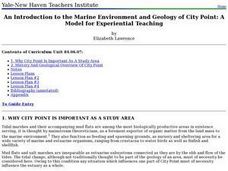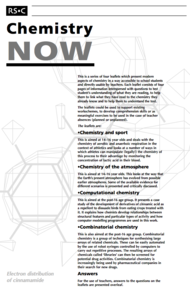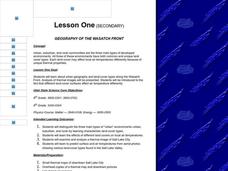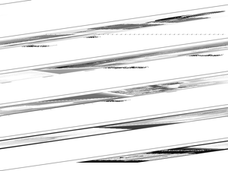Curated OER
A Tool for the Environment
In this desalting salt water activity, students will read about three different methods of desalting sea water which includes distilling, crystallizing, and filtering. Students will describe these methods in three short answer questions...
Curated OER
Great Salt Lake
Fourth graders make an ecosystem that brine shrimp can live in and take data as to what level of salinity the water is, how cold it is, and other data that students may think is important. They also hypothesize and predict the outcomes...
Curated OER
An Introduction to the Marine Environment and Geology of City Point: A Model for Experiential Teaching
Students begin the lesson by researching the history of City Point, Connecticut. Using a map, they color areas they were asked to find and discuss why the areas are important to the community. As a class, they are shown recent slides...
Georgian Court University
Introduction to Marsh Ecology
Compare and contrast the characteristics of fresh and salt water marshes. After exploring the typical plants and animals found in each marsh type, participants use a set of flash cards to sort into fresh and salt water marsh life. Their...
Royal Society of Chemistry
Computational Chemistry—Chemistry Now
Can some plants make their own animal repellents? Science sleuths examine the properties of cinnamamide in pear trees using an case study about computational chemistry. The resource discusses how vital computers are to research, how...
Smithsonian Institution
Who's in Camp?
Pupils complete readings, a group activity using cards, and a writing activity to better understand people's lives during the American Revolution. The resource emphasizes people such as the militiamen, women, officers, and children,...
Curated OER
Geography of the Wasatch Front
Young scholars examine and discuss urban geography and land-cover types along the Wasatch Front. They analyze thermal images, create collages, and predict surface and air temperatures from aerial photos in the Salt Lake City Valley.
Curated OER
Osmosis
Students investigate osmosis and diffusion in a liquid environment. In this osmosis lesson plan, students use dialysis tubing made into bags and filled with 3 different solutions. They observe the movement of water molecules into higher...
Curated OER
Ice Energy
Learners study the concept of ice energy. In this ice energy lesson, students observe what happens when salt is sprinkled on a piece of ice before following a recipe to make two types of ice cream. They note the difference in the two...
Curated OER
Parts of an Ecosystem
Fourth graders study the Great Salt lake and the ecosystem that encompasses it. They study the relationship between an individual of a species, a population of that species, a community that includes that population, and the...
Curated OER
Bacterial growth
Students explore the exponential growth and decay of microbial populations in relation to the organism tolerance ranges in their environment, They observe the impact of changing variables which can affect microbial populations.
Curated OER
Earth Science
Students analyze the mechanisms for generating ocean currents, temperature, and deep ocean circulation. They are able to assess the formation and breaking of waves and their effect on shorelines, particularly the North Carolina coast. ...
Curated OER
Heat Transfer & Phase Changes
In this heat transfer and phase change worksheet, students experiment with ice, salt, and milk to show the relationship between the temperature of a solution and its phase. Students turn milk from a liquid to a solid and graph the...
Curated OER
The Open Ocean, What is it and How Does it Change?
Students investigate the ocean environment. For this ocean lesson, students discover the physical properties of the ocean. Over two days, students work in small groups investigating ocean maps and creating water currents.
Curated OER
Osmosis Investigation
Students investigate osmosis as they determine how carrot cells respond to two different environments. They conduct the experiment, record the data, and answer discussion questions.
Curated OER
Plasmolysis in Elodea Plant Cells
Students microscopically observe various subcellular components. They determine the effects of different salt solutions on Elodea plant cells. They detect the presence of chloroplasts, cell walls, and cell membranes of Elodea.
Curated OER
Introduction to Algae
Students explore different types of algae found in both local regions of Salt Lake and different parts of the world. They discover different types of algae found in an ecosystem and the significance and function it serves.
Curated OER
My Senses Tell Me...
Learners explore how to use their sense to draw conclusions. In this human biology lesson, students use their senses to observe various objects in learning centers. The centers include tasting salt, touching sandpaper, hearing bells and...
Curated OER
Wetlands and Saltmarshes
Students identify the different functions of a wetland system and why the system is important to the St. Mary's River ecosystem and the environment. They play a migration game and write a journal about the salt marsh periwinkle and how...
Curated OER
Waterdrops
In this science activity, students learn about water resources and watersheds by reading and answering questions in this 8 pages newsletter. Students learn about salt vs. fresh water, discover the protective role of estuaries, learn...
Curated OER
Its OK To Be a Clod
Middle schoolers describe factors that affect the solubility of a chemical substance in seawater. In this sea environment instructional activity, student explain how information on the solubility of a substance can be used to measure...
Curated OER
Microorganisms
Though there are seventy-seven slides in this PowerPoint, only small bits of information are presented on each. It outlines the roles microorganisms play in the environment and spends time listing characteristics of each four different...
Curated OER
Geography of the Wasatch Front
Students identify the three main types of urban environments by learning characteristic land-cover types. They examine and analyze a thermal image of Salt Lake City. Then they predict surface and air temperatures from aerial photos.
Curated OER
Reduced Fare
Students discover the relationship between tectonic plate boundaries and the communities of life that thrive at such boundaries. In this biology lesson plan, students find that methane from oxidized carbon in sediments provides nutrients...

























